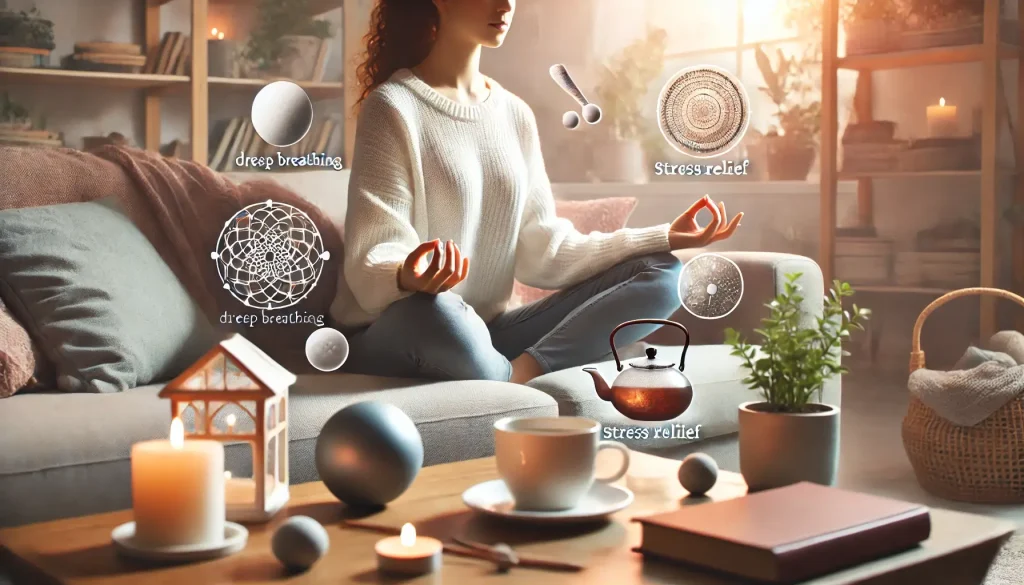In today’s fast-paced world, finding moments of calm amid the chaos is essential. Stress Relief Techniques offer practical and accessible methods for busy individuals to reduce anxiety, enhance focus, and maintain overall well-being. This comprehensive guide explores a variety of simple yet effective Stress Relief Techniques that can be easily integrated into even the most hectic schedules, empowering you to reclaim peace and boost productivity every day.

Index
Understanding Stress and Its Impact
Before diving into effective Stress Relief Techniques, it’s important to understand what stress is and how it affects your body and mind. Stress is a natural response to challenging situations, but chronic stress can have significant negative consequences, including:
- Increased Cortisol Levels: Prolonged stress elevates cortisol, which can contribute to weight gain, decreased immunity, and skin issues.
- Mental Fatigue: Constant stress can lead to mental exhaustion, reduced concentration, and impaired decision-making.
- Physical Health Issues: Stress is linked to high blood pressure, heart disease, and other serious health conditions.
Recognizing the signs of stress is the first step towards implementing Stress Relief Techniques that work for you.
Mindfulness and Meditation
Mindfulness is at the core of many effective Stress Relief Techniques. It involves being fully present in the moment, which can help break the cycle of stress and anxiety.
Meditation Practices
- Guided Meditation: Using apps like Headspace or Calm, even a 10-minute session can clear your mind and lower stress levels.
- Breathing Meditation: Focus on your breath—inhale deeply, hold for a few seconds, and exhale slowly. This simple technique can help center your thoughts and reduce anxiety.
- Body Scan Meditation: Mentally scan your body from head to toe, releasing tension in each muscle group. This practice promotes relaxation and awareness of stress points.
Mindfulness Exercises
- Mindful Walking: Take a short walk and focus on the sensation of your feet touching the ground, the sounds around you, and the rhythm of your breath.
- Mindful Listening: Listen to calming music or natural sounds, allowing yourself to fully experience each note or sound without distraction.
- Gratitude Journaling: Spend a few minutes each day writing down things you are grateful for. This practice shifts focus from stress to positive experiences, contributing to overall mental clarity.
These mindfulness practices are essential Stress Relief Techniques that help calm your mind, allowing you to approach daily challenges with a clearer perspective.
Physical Activity for Stress Reduction
Regular exercise is one of the most effective Stress Relief Techniques available. Physical activity not only improves physical health but also helps reduce stress through the release of endorphins, the body’s natural mood boosters.
Cardiovascular Exercise
- Walking or Jogging: Even a brisk 20-minute walk can boost your mood and clear your mind.
- Cycling: A fun, low-impact way to get your heart rate up and improve circulation.
- Dancing: Whether it’s in a class or in your living room, dancing is a joyful and effective stress reliever.
Strength and Flexibility Training
- Yoga: Combines physical postures with breathing exercises and meditation, offering a comprehensive approach to stress relief.
- Pilates: Focuses on core strength and flexibility, helping to reduce physical tension and improve posture.
- Resistance Training: Lifting weights or using bodyweight exercises can help release pent-up energy and improve overall physical resilience.
Engaging in regular physical activity not only serves as an effective Stress Relief Technique but also enhances overall well-being by improving sleep, boosting self-esteem, and increasing energy levels.
Deep Breathing Techniques
Deep breathing is a simple yet powerful Stress Relief Technique that can be performed anywhere, anytime, to help calm the nervous system and reduce anxiety.
Effective Breathing Exercises
- 4-7-8 Breathing: Inhale for 4 seconds, hold your breath for 7 seconds, and exhale for 8 seconds. This technique helps lower cortisol levels and promotes relaxation.
- Box Breathing: Inhale for 4 seconds, hold for 4 seconds, exhale for 4 seconds, and hold again for 4 seconds. This rhythmic breathing pattern can stabilize your emotions during stressful moments.
- Alternate Nostril Breathing: Close one nostril and breathe in, then switch and breathe out through the other. This exercise balances the nervous system and improves concentration.
Regular practice of these deep breathing exercises can quickly transform your state of mind, making them essential Stress Relief Techniques for busy days.
Digital Detox and Unplugging
In our hyper-connected world, constant digital stimulation can contribute significantly to stress. Implementing a digital detox is an effective Stress Relief Technique that allows your mind to rest and recharge.
Steps for a Digital Detox
- Set Boundaries: Establish specific times during the day when you disconnect from social media, emails, and digital devices.
- Create a Tech-Free Zone: Designate certain areas of your home, like the bedroom or dining room, as tech-free spaces.
- Engage in Offline Activities: Replace screen time with reading, hobbies, or spending time in nature. These activities promote relaxation and mindfulness.
A regular digital detox can help reduce information overload and mental fatigue, making it a vital part of your Stress Relief Techniques toolkit.
Creative Outlets and Hobbies
Engaging in creative activities provides a healthy distraction from stress and helps express emotions constructively. Whether you’re painting, writing, gardening, or playing music, creative outlets are powerful Stress Relief Techniques.
Benefits of Creative Expression
- Emotional Release: Expressing creativity can help process and release built-up emotions.
- Improved Focus: Hobbies that require concentration can shift your focus away from stressors and provide a mental break.
- Sense of Accomplishment: Creating something tangible can boost self-esteem and foster a positive outlook.
Incorporating a regular creative practice into your routine is an excellent way to manage stress and add joy to your day.
Practical Stress Management Tips for Busy Days
Integrating Stress Relief Techniques into a busy schedule requires simple, actionable strategies that can be easily adopted. Here are some practical tips:
1. Schedule Short Breaks
- Micro-Breaks: Even 5 minutes of deep breathing or a quick walk around the office can reset your stress levels.
- Regular Intervals: Set reminders to take short breaks throughout the day, ensuring you don’t get overwhelmed by continuous work.
2. Prioritize Tasks
- Time Management: Use to-do lists and prioritization techniques like the Eisenhower Box to manage your workload effectively.
- Delegate When Possible: Don’t hesitate to delegate tasks or ask for help. This reduces your burden and minimizes stress.
3. Create a Relaxing Environment
- Personal Space: Organize your workspace to be clutter-free and calming. Add personal touches like a plant or soothing images.
- Ambient Music: Listening to calming music can lower stress levels and improve concentration. Create a playlist of your favorite relaxing tunes to play during work.
4. Practice Self-Compassion
- Positive Affirmations: Remind yourself that it’s okay to take breaks and that your well-being is important. Positive self-talk can alleviate self-imposed stress.
- Celebrate Small Wins: Acknowledge your accomplishments, no matter how small. This fosters a positive mindset and reduces overall stress.
Integrating Stress Relief Techniques into Your Daily Life
The key to managing stress effectively is consistency. Integrate these Stress Relief Techniques into your daily routine to create lasting change:
- Morning Ritual: Start your day with a brief meditation or deep breathing session to set a calm tone.
- Midday Check-In: Use scheduled micro-breaks to step away from your work and reset your mind.
- Evening Wind Down: End your day with a digital detox, a relaxing hobby, or gentle stretching to prepare your body and mind for rest.
By weaving these practices into your daily life, you’ll build a strong foundation for stress management that supports both your mental clarity and physical well-being.
Real-Life Success Stories
Many individuals have transformed their daily routines by embracing effective Stress Relief Techniques. Consider these inspiring examples:
- Alex’s Transformation: Alex, a busy marketing executive, started incorporating 10 minutes of guided meditation into his morning routine. Within weeks, he noticed improved focus and a more positive outlook, attributing much of his newfound energy to consistent practice of Stress Relief Techniques.
- Maria’s Journey: As a freelance writer, Maria struggled with work-induced anxiety. She began scheduling short, frequent breaks throughout her day to practice deep breathing and stretch. This simple change significantly reduced her stress levels and improved her productivity.
- Jasmine’s Lifestyle Shift: Jasmine, a mother of two, found that her daily stress was affecting her skin and overall health. By integrating regular yoga sessions, creative hobbies, and a digital detox into her routine, she not only managed her stress but also experienced a noticeable boost in her overall well-being.
Future Trends in Stress Relief Techniques
As research into the mind-body connection evolves, new Stress Relief Techniques and tools continue to emerge. Some promising future trends include:
- Personalized Stress Management Apps: Advances in wearable technology and AI will enable personalized stress tracking and tailored relaxation techniques based on real-time data.
- Virtual Reality Meditation: VR platforms are being developed to create immersive meditation experiences, providing a more engaging way to practice mindfulness.
- Smart Workspaces: The integration of wellness features in office environments—such as adjustable lighting, soundscapes, and ergonomic designs—will further support stress management in professional settings.
- Holistic Wellness Programs: Companies are increasingly adopting comprehensive wellness programs that combine physical, mental, and emotional health practices, making effective Stress Relief Techniques a core part of daily work culture.
Conclusion
Implementing effective Stress Relief Techniques is crucial for maintaining a balanced, healthy life, especially in today’s busy world. By integrating mindfulness, physical activity, creative outlets, and practical self-care strategies into your daily routine, you can reduce stress and foster an environment where both your mind and skin can thrive.
Every small step you take toward managing stress not only enhances your overall well-being but also paves the way for clearer, more radiant skin and a more focused, positive mindset. Embrace these Stress Relief Techniques and transform your busy days into moments of peace and rejuvenation.
For more expert insights, detailed tutorials, and continuous inspiration on managing stress and achieving holistic well-being, visit our website at eu.artereciclada.com.br.
